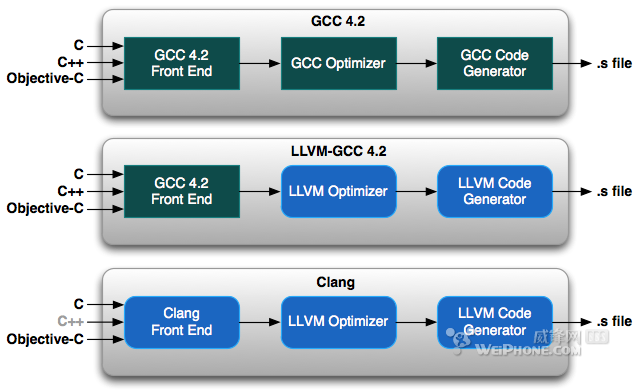简单讲,编译器就是将“高级语言”翻译为“机器语言(低级语言)”的程序。一个现代编译器的主要工作流程:源代码 (source code) → 预处理器 (preprocessor) → 编译器 (compiler) → 汇编程序 (assembler) → 目标代码 (object code) → 链接器 (Linker) → 可执行程序 (executables)
Structure of a compiler
Compilers bridge source programs in high-level languages with the underlying hardware. A compiler requires 1) determining the correctness of the syntax of programs, 2) generating correct and efficient object code, 3) run-time organization, and 4) formatting output according to assembler and/or linker conventions. A compiler consists of three main parts: the frontend, the middle-end, and the backend.
The front end checks whether the program is correctly written in terms of the programming language syntax and semantics. Here legal and illegal programs are recognized. Errors are reported, if any, in a useful way. Type checking is also performed by collecting type information. The frontend then generates an intermediate representation or IR of the source code for processing by the middle-end.
The middle end is where optimization takes place. Typical transformations for optimization are removal of useless or unreachable code, discovery and propagation of constant values, relocation of computation to a less frequently executed place (e.g., out of a loop), or specialization of computation based on the context. The middle-end generates another IR for the following backend. Most optimization efforts are focused on this part.
The back end is responsible for translating the IR from the middle-end into assembly code. The target instruction(s) are chosen for each IR instruction. Register allocation assigns processor registers for the program variables where possible. The backend utilizes the hardware by figuring out how to keep parallel execution units busy, filling delay slots, and so on. Although most algorithms for optimization are in NP, heuristic techniques are well-developed.

java编译执行过程:

通俗说明:Java中引入了虚拟机的概念,即在机器和编译程序之间加入了一层抽象的虚拟的机器。这台虚拟的机器在任何平台上都提供给编译程序一个的共同的接口。编译程序只需要面向虚拟机,生成虚拟机能够理解的代码,然后由解释器来将虚拟机代码转换为特定系统的机器码执行。在Java中,这种供虚拟机理解的代码叫做字节码(ByteCode),它不面向任何特定的处理器,只面向虚拟机。每一种平台的解释器是不同的,但是实现的虚拟机是相同的。Java源程序经过编译器编译后变成字节码,字节码由虚拟机解释执行,虚拟机将每一条要执行的字节码送给解释器,解释器将其翻译成特定机器上的机器码,然后在特定的机器上运行。
参考:
http://en.wikipedia.org/wiki/Compiler